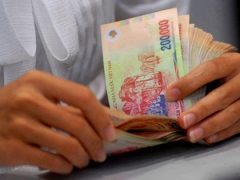Vietnam dong to devaluate 2.5pct at most: ANZ
The foreign exchange rate between the Vietnam dong and US dollar is expected to increase to only VND21,500 a dollar, and the 2012 BoP will double last year’s value of $3 billion, said ANZ.
The data also shows the stability of the local greenback in the first half of this year and is a step forward in the ability of the central bank to protect the local currency strength.
Although the current account faced certain pressures in the first half of this year, the BoP for the whole of 2012 will still be in surplus, said ANZ.
Thanks to the positive signs in the trade balance and inflation in H1/2012, the local currency will only face a slight depreciation risk during the remaining months.
An abundant amount of remittances will help limit the pressure on the current account, and FDI disbursement processes will help stabilize the BoP.
Tran Hoang Ngan, a member of the National Assembly’s Economic Committee cum vice rector of Ho Chi Minh City Economics University, told Thoi Bao Kinh Te Saigon newspaper that Vietnam’s BoP in H1/2012 enjoyed a surplus of $7 billion as the trade deficit shrank and foreign currency reserves increased.
According to Ngan, these factors are expected to stabilize the dong/US dollar forex rate in Q3/2012.
Earlier, according to the Ministry of Planning and Investment’s socioeconomic report in the first four months of 2012, the country’s balance of payments in Q1/2012 was estimated to enjoy a surplus of $2 billion.
Some sources have said that Vietnam should devalue the local currency, but Ngan insists that now is not the right time.
Though the country’s consumer price index (CPI) in June decreased partly due to external elements such as steadily falling oil prices and prices of other commodities, the resilience of the European economy is still an unknown, and if it recovers, the prices of these commodities will likely increase again.
In Vietnam, the prices of electricity, water and coal for electricity production have increased, affecting costs and lowering support for low inflation in the future.
For the aforementioned reasons, Ngan said that if the dong were devalued now, there would be a strong chance that high inflation would return for Q4/2012.
State Bank of Vietnam (SBV)’s governor Nguyen Van Binh early this year said the forex rate between the Vietnam dong and US dollar would not be adjusted more than 3 percent in 2012.
He told newswire Vnexpress late last year that Vietnam’s BoP is forecasted to enjoy a surplus of $2 billion in 2012 thanks to a lower trade deficit and stable forex rate management policy.
Technology firms have bigger role
The role of technology enterprises in enriching Vietnam’s BoP will grow more and more, said the Analysis Division of ANZ in a report on emerging economies in Asia last month.
The export values of technological products such as computer components, mobile phones, and mobile phone accessories has doubled year on year, while the export turnover of some key commodities remained unchanged or declined.
Technological products made the biggest contribution to the country’s total export turnover which is always at a two-digit ratio level.
The trading value of technological products has contributed to narrowing the trade balance as well as changing the trade structure of Vietnam.
Technological products are the country’s second biggest export item, just after apparel products. Currently, the export ratio of electronic products and telephones are equal to 17 percent and 11 percent of the total export turnover, while the figures were only 8 percent and 1 percent in 2010.
Moreover, this is a promising sector for foreign direct investment (FDI) inflows with very strong growth. About 6 percent of the total pledged FDI capital in 2011 was poured into the information technology industry.
Meanwhile, FDI in the manufacturing sector, including the electronics sector, dominated.
According to ANZ, the growth of technology exports will help reduce the trade deficit by $9-10 billion per year in the next years.
On average, the trade deficit in the next five years will be at more than $13 billion.
In the same time period the BoP will enjoy a surplus of $6-7 billion per year.
With the growth of technology exports, ANZ forecasts Vietnam’s current account balance deficit in this period will be at 4-5 percent of gross domestic product (GDP), while it was at 6-7 per cent of GDP in the previous period.
What the stars mean:
★ Poor ★ ★ Promising ★★★ Good ★★★★ Very good ★★★★★ Exceptional
Related Contents
Latest News
More News
- Vietnam’s green transition demands collective financial action (December 15, 2025 | 12:00)
- VIR workshop highlights capital and policy for sustainable development (December 15, 2025 | 11:00)
- Promoting digital assets initiative in Vietnam (December 13, 2025 | 09:30)
- Experts flag gaps as national financial strategy under review (December 12, 2025 | 15:13)
- Global gold exchange models offer roadmap for Vietnamese market (December 12, 2025 | 11:58)
- Five million household businesses to adopt self-declared tax system (December 11, 2025 | 18:13)
- Vietnam establishes management board for crypto asset trading market (December 11, 2025 | 18:11)
- ACB offers financing to fit Vietnam’s textile and garment industry (December 11, 2025 | 09:07)
- Vietnam accelerates push for open banking (December 10, 2025 | 11:58)
- Reshaping the country’s digital finance sector (December 09, 2025 | 21:12)


 Tag:
Tag:





















 Mobile Version
Mobile Version